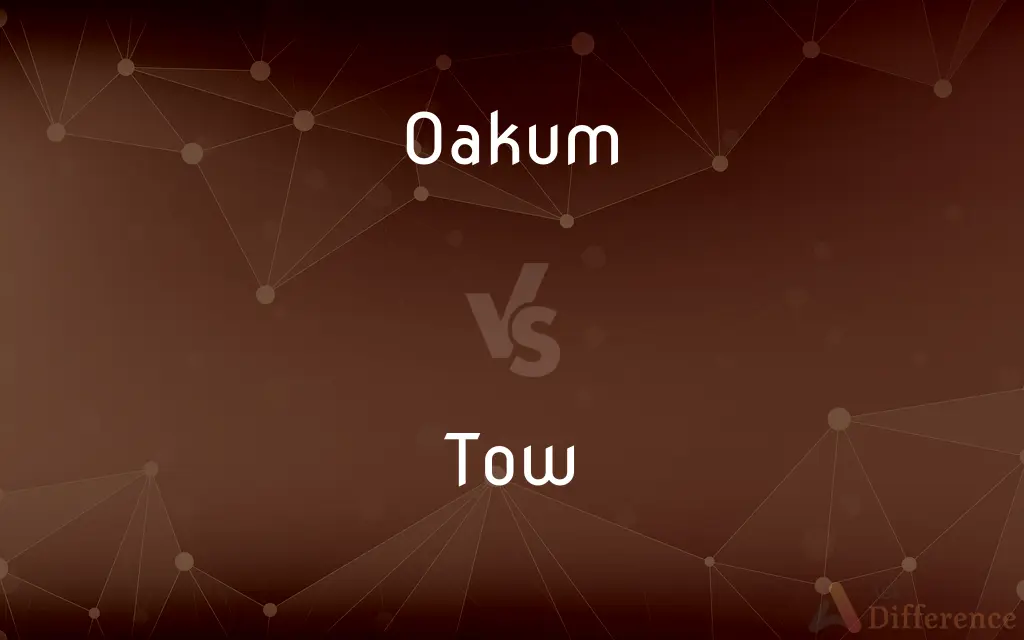Oakum vs. Tow — What's the Difference?
By Maham Liaqat & Fiza Rafique — Updated on April 24, 2024
Oakum is a fiber material used for caulking, made from old ropes, while tow is short or broken fibers from flax, hemp, or jute, primarily used in spinning and stuffing.

Difference Between Oakum and Tow
Table of Contents
ADVERTISEMENT
Key Differences
Oakum is traditionally made by untwisting old hemp or jute ropes, which are then treated with tar. This process makes it suitable for caulking or sealing the joints in wooden ships and plumbing. Whereas, tow consists of the shorter fibers that are separated from the longer fibers (line) during the process of breaking and scutching flax or hemp. These fibers are generally less strong and are used for less critical applications.
Oakum's impregnation with tar provides it with resistance to water and pests, making it ideal for maritime uses. On the other hand, tow is often untreated and retains a natural, softer texture, making it preferable for use in home textiles, such as stuffing for upholstery.
In historical contexts, oakum was also used as a punishing task in workhouses or prisons, where inmates picked apart old ropes. Tow, whereas, has been a valuable resource in traditional hand-spinning crafts, providing a fibrous material that could be easily accessed and processed by rural populations.
The production of oakum can be labor-intensive, as it involves manually untwisting and teasing out the fibers from ropes. On the other hand, the production of tow is somewhat automated, resulting from the mechanical processing of raw flax or hemp.
Comparison Chart
Material Source
Old hemp or jute ropes
Short or broken flax, hemp, or jute fibers
ADVERTISEMENT
Primary Use
Caulking in ships and plumbing
Spinning and stuffing
Processing
Untwisting and tar treatment
Separation during scutching
Texture and Treatment
Coarse and tarred
Softer and usually untreated
Historical Use
Maritime and penal labor
Hand-spinning and craft material
Compare with Definitions
Oakum
Tarred fibres from old ropes, used in plumbing.
We need more oakum to stop the leak in this old pipe.
Tow
A resource for hand-spinning enthusiasts.
Tow offers an accessible material for beginners in spinning.
Oakum
Traditionally used in shipbuilding for sealing joints.
Oakum has been essential for wooden ship construction.
Tow
Short or broken fibers from plants like flax or hemp.
The spinner used tow to create a coarse but durable fabric.
Oakum
Durable and water-resistant caulking material.
Oakum's durability makes it ideal for underwater applications.
Tow
A byproduct from processing hemp or flax.
The farm's flax processing yields a significant amount of tow.
Oakum
A material made from old ropes, used for caulking.
The boat builder used oakum to seal the wooden hull.
Tow
Used for stuffing in traditional upholstery.
We stuffed the old chair with tow to restore its original comfort.
Oakum
Laboriously picked fiber, historically a form of penal labor.
Prisoners were often tasked with picking oakum.
Tow
Softer and less processed than other fibers.
Tow is preferred for its softness in homemade crafts.
Oakum
Oakum is a preparation of tarred fibre used to seal gaps. Its main traditional applications were in shipbuilding, for caulking or packing the joints of timbers in wooden vessels and the deck planking of iron and steel ships; in plumbing, for sealing joints in cast iron pipe; and in log cabins for chinking.
Tow
To draw or pull behind by a chain or line
A tugboat towing a barge.
Oakum
Loose hemp or jute fiber, sometimes treated with tar, creosote, or asphalt, used chiefly for caulking seams in wooden ships and packing pipe joints.
Tow
The act or an instance of towing
Can you give my car a tow?.
Oakum
A material, consisting of tarred fibres, used to caulk or pack joints in plumbing, masonry, and wooden shipbuilding.
Tow
Something, such as a tugboat, that tows.
Oakum
The coarse portion separated from flax or hemp in hackling.
Tow
Something, such as a barge or car, that is towed.
Oakum
The material obtained by untwisting and picking into loose fiber old hemp ropes; - used for calking the seams of ships, stopping leaks, etc.
Tow
A rope or cable used in towing.
Oakum
The coarse portion separated from flax or hemp in nackling.
Tow
Coarse broken flax or hemp fiber.
Oakum
Loose hemp or jute fiber obtained by unravelling old ropes; when impregnated with tar it was used to caulk seams and pack joints in wooden ships
Tow
A continuous untwisted bundle of manufactured fibers.
Tow
(transitive) To pull something behind one using a line or chain; to haul.
Tow
To aid someone behind by shielding them from wind resistance.
Tow
The act of towing and the condition of being towed.
It isn't the car's battery; I think I need a tow.
Tow
Something, such as a tugboat, that tows.
Tow
Something, such as a barge, that is towed.
Tow
A rope or cable used in towing.
Tow
(motor racing) A speed increase given by driving in front of another car on a straight, which causes a slipstream for the car behind.
Tow
An untwisted bundle of fibres such as cellulose acetate, flax, hemp or jute.
Tow
(specifically) The short, coarse, less desirable fibres separated by hackling from the finer longer fibres (line).
Tow
The coarse and broken part of flax or hemp, separated from the finer part by the hatchel or swingle.
Tow
A rope by which anything is towed; a towline, or towrope.
Tow
The act of towing, or the state of being towed; - chiefly used in the phrase, to take in tow, that is to tow.
Tow
That which is towed, or drawn by a towline, as a barge, raft, collection of boats, ect.
Tow
To draw or pull through the water, as a vessel of any kind, by means of a rope.
Tow
The act of hauling something (as a vehicle) by means of a hitch or rope;
The truck gave him a tow to the garage
Tow
Drag behind;
Horses used to tow barges along the canal
Common Curiosities
How is tow processed?
Tow is obtained during the scutching process where shorter fibers are separated from the longer fibers of flax or hemp.
Is oakum still used today?
Yes, it is used in traditional boat building and in some old plumbing systems.
What is oakum used for?
Oakum is primarily used for caulking and sealing joints in wooden boats and old plumbing.
What are the primary uses of tow?
Tow is used for spinning into yarn and for stuffing in textiles like upholstery.
How is oakum made?
It is made by untwisting and tar-treating the fibers from old hemp or jute ropes.
Can tow be used in modern textile production?
Yes, it is often used in non-woven fabrics and as a raw material in the production of paper or felt.
How environmentally friendly are oakum and tow?
Both are biodegradable, but the tar in oakum can contribute to environmental concerns.
Was oakum ever a commercial product?
Yes, it was widely sold and used for maritime and plumbing applications.
Is tow suitable for all types of spinning?
No, it's best suited for producing coarser, less refined yarns.
What is the difference in texture between oakum and tow?
Oakum is coarse and often tarred, whereas tow is softer and usually untreated.
Share Your Discovery

Previous Comparison
Handoff vs. Handover
Next Comparison
Tryptone vs. CaseinAuthor Spotlight
Written by
Maham LiaqatCo-written by
Fiza RafiqueFiza Rafique is a skilled content writer at AskDifference.com, where she meticulously refines and enhances written pieces. Drawing from her vast editorial expertise, Fiza ensures clarity, accuracy, and precision in every article. Passionate about language, she continually seeks to elevate the quality of content for readers worldwide.













































